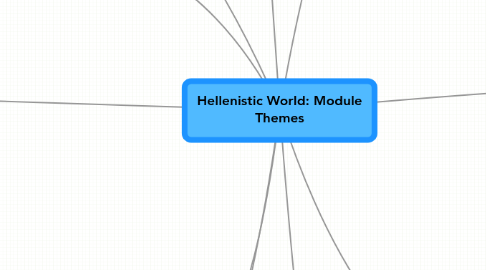
1. Rome as a Hellenistic state
1.1. interdisciplinary approaches to antiquity
1.1.1. object biography
1.1.2. political science
1.1.3. iconology
1.1.3.1. 'image biography'
1.1.3.2. reception studies - Warburg, Mnemosyne.
1.2. repeatedly brought into conflicts between Hellenistic kingdoms
1.2.1. why does Rome expand? Gruen (empire by invitation - Attalids + Ptolemies and wills), Harris (Rome is the aggressor, uniquely so), Eckstein (realism - interstate anarchy, a system of constant warfare that has to end in one power winning out)
2. warfare
2.1. mercenaries and the associated problems of what to do with them when not fighting
2.2. Rome as a Hellenistc state. Hellenistic monarchies have a particular style of warfare, which Rome doesn't share. Gives them the advantage. Seen at Beneventum, Cynescepholae. Greeks have static tactics, Romans more innovative. e.g. defeating Pyhrrus' elephants - Romans take a chariot (or some invention) from the Carthaginians (Find source????)
3. The Hellenistic West
3.1. Sicily
3.1.1. evidence for ruler cult - inscription for Zeus Soter Hieron -0 evidence of the beginnings of ruler cult in the west.
3.1.2. coinage - Hieron II on staters with diadem and presents himself like a Ptolemy. Proliferation of Ptolemaic bronzes on Sicily. A Ptolemaic mint (or mint workers) sent to Hieron by Ptolemy. Hieron II continues to strike these coins after the Ptolemaic mint has left.
3.1.3. strong relationship with Egypt. Gifting of the ship called the Syracusa to Egypt. Egypt building a later ship - tessarakontes.
3.2. Numidia
4. Cultural Developments
4.1. literary
4.1.1. Callimachus
4.1.2. development of texts focused on military tactics
4.2. artistic
5. Representation of the Hellenistic world in post-Hellenistic cultures
5.1. digital storytelling
5.2. Rome
5.3. TEI and the Archive of Hor
5.4. object biography
5.4.1. Rosetta stone
5.4.1.1. used for decipherment of hieroglyphs
6. The Transformative Effects of Philip and Alexander
6.1. military transformations
6.1.1. sarissa (spear) + phalanx
6.1.2. military tactics + use of cavalry
6.1.2.1. texts about tactics, Strategamata
6.1.2.1.1. strategems of Polynaenus
6.1.2.2. siege engineers and siege equipment under Philip
6.1.3. professional army under Philip
6.1.3.1. Diodorus Siculus - development of the Macedonian pahalanx
6.1.3.2. mercenaries
7. Consolidation of power by Hellenistic monarchs
7.1. Cities
7.1.1. Alexandria
7.1.2. Memphis
7.2. material culture
7.3. ruler cult
7.3.1. Arsinoe II
7.3.2. Rosetta stone - created by the priests Ptolemy V - setting up of statues
7.3.3. brother sister gods (coins)
7.3.4. Berenike - Callimachus, Lock of hair poem
7.3.5. Demetrius Poliorcetes in Athens - parades
7.3.6. whats new is individualism - as opposed to hero cult, cult worship of humans. Ruler cult - proliferation of different types of honors,. The appaearance of someone on a coin who had once lived
7.3.7. connected to the local tradition in Egypt of deifying their rulers
7.3.8. Selecuids - ruled over diverse environments - could not build on an existing tradition, so it was much more difficult than the Ptolemies.
7.3.9. spectrum - Hellenistic period its not cities bestowing honours on rulers, but rulers demanding them of cities. Letter from Antiochus IV (cult to his wife?), Ptolemy IV priest of Alexander and Ptolemy in Egypt
7.4. economy
7.5. engagement with local power structures
7.5.1. Rosetta stone
8. interaction of cultures and how to understand this
8.1. spread of greek culture
8.1.1. Alexandria and Memphis
8.1.2. settlement of veterans under Ptolemy II + III
8.1.3. billeting in Egypt
8.1.4. foundation of Hellenistic cities
8.1.4.1. Alexandria, Seleucia, Antioch
8.1.4.1.1. also connected to monarchies and individualism - cities named after rulers.
8.1.4.2. cuneiform tablet - Antiochus moving Greek settlers into the city of Babylon
8.1.5. building of gymnasium in Jerusalem, sacrificing of pigs in the temple - causes conflict
8.2. 'Hellenism'
8.2.1. Rosetta stone - different languages. Greek, hieroglyphs and demotic.
8.3. code switching
8.3.1. use of different languages - different audiences receiving slightly messages
8.3.2. Ptolemy I - difference between being king and being pharaoh.
8.4. universal vs particular
8.4.1. Hellenistic koine - universal
8.4.2. e.g. Numidian kings - Kbor Klib, use of 'Hellenistic' (Macedonian) motifs, but made 'local' through placement, adaptation (e.g. Numidian style weaponry).
8.4.3. Rome and her coinage - takes a 'Hellenistic image' (Dioscuri).
9. proliferation of monarchies + individualism
9.1. Royal queens
9.1.1. Arsinoe II
9.1.2. Berenike
9.2. culture of honoring individuals in a formal and honorific way
9.2.1. Rosetta stone
9.2.2. also honoring of individuals in Greek cities
9.2.2.1. Ma - peer polity interaction
9.3. The beginnings of monarchy after the death of Alexander
9.3.1. Ptolemy I - gold staters align him with Alexander, diademed. Coronation as pharoah. King basileus on coins, formally coronated as pharaoh later
10. experience of Greek cities
10.1. Demetrius Poliorcetes + Antigonus
10.1.1. freedom, honours in Athens - two tribes in Athens, Hymn to Demetrius - the 'only true god'
10.2. freedom of the Greeks!
10.2.1. Romans claim this as well - Flamininus
